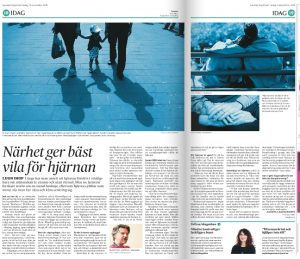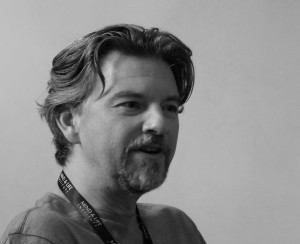It has long been thought that the brain is put to its least activity when we are alone and without any stimuli. But new findings show that our brain’s best energy-saving mode is together with others. The baseline is social, not individual, claims psychology professor James Coan at University of Virginia. ”And when you’re with your closest ones around, the brain is working even less.”
Right now, you can watch a computer-animated film with five basic emotions starred in the 11-year-old Riley’s head. “Inside Out” is trying to portray how feelings arise and what role their signals play in our actions.

Perhaps a similar movie should be produced, but with the brain’s Minister of Energy in the lead part. Because, according to new hypotheses, the brain, in all situations, makes a kind of fuel calculation – access, consumption, conserving – and ensures that we consume as little energy as possible.
And – it turns out that the most energy-saving mode, all categories, is to have people you trust around you. The closer the relationship, the less energy the brain needs to use.

”The access to social resources seems to have a power-saving function, and is probably a prerequisite for the human brain”, claims psychology professor James Coan. At a conference outside New York in June he presented a new theory of the brain’s actual “default”, or sleep mode:
”When we’re together with others, the energy the brain spends on solving problems is decreased dramatically. It’s like social proximity is signaling to the brain that it can return to, or remain at rest.”
So people around us, James Coan and his fellow researchers believe, is more likely to put our brain in a ”default”-mode than being alone, which previously was thought to be true. Instead of an ”Individual Baseline” – that the brain would be the least active in a room with no stimuli – their studies have shown that interaction, interdependence and shared goals allows the brain to conserve its energy the best. “Social baseline theory” they call this new idea for how the brain is wired .
”Being around other people alters how our brain works. So I don’t think the baseline is individual, but come from a collectivistic element in our evolution.”
Here is how the theory is constructed:
Ecology: Man does not exist in any special climatic or plant zones, instead our typical ecological environment is just other people. Here, our brain has evolved to operate and, according to Social Baseline Theory, automatically counts with others to solve problems.
Economy of action: The resources we provide to survive are not endless. The brain’s 20 percent’s share of the daily calories is constant, “it doesn’t get more because we think very hard” – so it really needs to economise. For this, the brain has a special ability to make estimates of whether an effort is worthwhile. One observation the researchers have made, is that being with others seems to optimize the energy consumption.
Managing resources: The brain’s ”Minister of Energy” can even fool the senses to perceive something too hard to do in order to save energy. ”Work costs, and not doing the work is cheaper” as James Coan puts it, and refers to studies in which subjects stand beneath a hill and are asked to estimate its steepness degree. On their own, the slope seems steeper than it is. With a heavy backpack – even steeper. But with a friend, they estimate it as flatter, and the longer the friendship, the less steep they perceive the hill.
”This is the kind of studies that support the hypothesis that human relationships have an energy-saving effect on the brain.”
Social proximity: James Coan has made research on what proximity and loving relationships do with the brain since the 1990’s. People have recieved light electric shocks while their brains are imaged in a scanner. Now and then they get warned with a red cross. If they see a blue circle, nothing is going to happen. Brain activities when these signals are cued are measured in three different situations: alone in the scanner, holding hands with a stranger and holding their partner’s hand.
”When they’re alone, the brain gets active all over the place. Not in a single nerve circuit, but everywhere. It seems to have a lot of problems to solve”, explains James Coan.
The results of several similar hand-holding experiments show the same thing: If you are alone, the brain perceives that it has to solve all the problems on its own. If you hold someone you don’t know by the hand, only certain brain activities remain. But holding hands with your loved one reduces all the stress reactivitiy in the brain completely.
”My mother isn’t impressed by my results and says, ‘That I already knew, why didn’t you call me?’. And of course, I can see the same effect when my four year old daughter wants to hold my hand before vaccination. She also knows that it helps. But as a scientist, I want to examine the mechanisms: how can the brain take a hand and turn it into less threat reactivity in the neural circuits?”
The brain is wired to have people around it – that is James Coan sure of. According to the research results, it is as if it ‘knows’ that others are interdependent – prepared to share goals with you, and have common interests.
”The brain percieves that there are fewer problems to solve when there are people close to you – and vice versa if you are alone. On your own is like carrying a heavy backpack, whatever effort you’re supposed to do.”
Why the effect of close relationships is energy-saving, researchers do not yet know, but speculates that it is about risk distribution and load sharing.
The theory of risk distribution is observed among ostriches, who must lower their head to get food, and also raise it to watch for predators. For each ostrich added to the flock, every single individual needs to raise its head less often. Yet the total vigilance of the flock is increased, as the time each one will have to get food.
Risk distribution, the researchers believe, may be one of the reasons that social proximity is saving energy for the brain.
But the brain also needs information about the quality of the social resources. How familiar, reliable and interdependent are they? Close relations mean that you have access to someone who might use their energy for you – we carry each others’ burdens. A kind of load sharing.
”We have not been able to confirm exactly which neural circuits are involved, but those associated with regulating emotions – and that costs a lot of energy – are less active in social relations. Together with others, the brain receives signals to return to the baseline, to a relatively calm.”
Social proximity regulate our emotions, and emotional processes control almost all brain activity. For example, collective intelligence, the problem-solving ability in groups, is not equal to the sum of everyone’s IQ, but rather how sensitive each team member is to read facial expressions. James Coan think it’s time to start talking about how we constantly influence each other.
Can we do something ourselves to make the brain save energy?
”Holding hands is very good, but anything we do to bond and interact will give the brain the security make it expect that we shared problem solving. In the West, we would save a lot of energy if we accepted a more collectivist identity. What if we could have a more broaden idea of how we’re held by people around us – in a shared world.”
Agneta Lagercrantz
Scientific papers by James Coan et al:
Social Baseline Theory and The Social Regulation of Emotion (Social Aspects 2014)
Social Baseline Theory: The role of Social Proximity in Emotion and Economy of Action (Social and Personality Psychology Compass 5/12, 2011)
Evidence of Emotional Load Sharing in Close Relationships (Daily Science, 2015-09-14)
TED-talk with James Coan: Why we hold hands

Verkligen mycket glad att säga, din artikel är väldigt intressant att läsa.